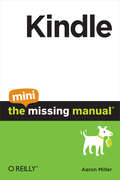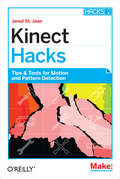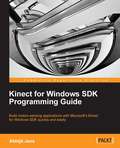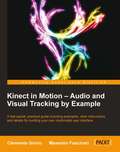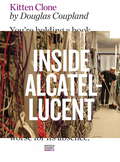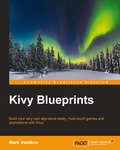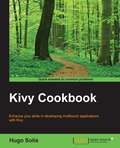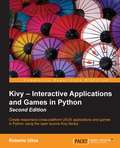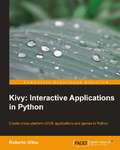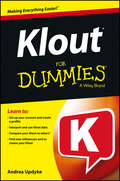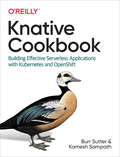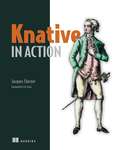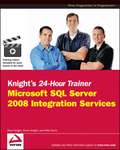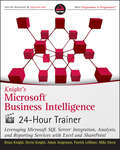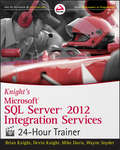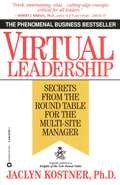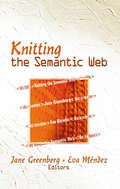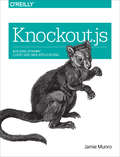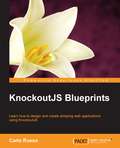- Table View
- List View
Kindle: The Mini Missing Manual
by Aaron MillerSo, you have your Kindle and are ready to start reading. Great! But did you know that you can play music on the Kindle while you are reading that new bestselling novel? How about sharing your thoughts about the book with friends via Facebook and Twitter? More than just an e-reader, Amazon's popular device lets you do those things and much more. You can create a custom calendar to help plan your day or remember your mom's birthday, calculate the tip at your favorite restaurant, and waste a little time and have fun playing games or surfing the web. Check out Kindle: The Mini Missing Manual to learn how to get the most out of your device.
Kinect Hacks: Tips & Tools for Motion and Pattern Detection
by Jared St. JeanCreate your own innovative applications in computer vision, game design, music, robotics, and other areas by taking full advantage of Kinect’s extensive interactive, multi-media platform. With this book, you get a step-by-step walkthrough of the best techniques and tools to come out of the OpenKinect project, the largest and most active Kinect hacking community.Learn dozens of hacks for building interfaces that respond to body movements, gestures, and voice, using open source toolkits such as openFrameworks, the Processing IDE, and OpenKinect driver library. Whether you’re an artist, designer, researcher, or hobbyist, this book will give you a running start with Kinect.Set up a development environment in Windows 7, Mac OSX, or UbuntuBuild special effects apps with tools such as Synapse and CinderCreate gestural interfaces to integrate and control digital music componentsCapture the realistic motions of a 3D model with NI mate, Blender, and AnimataDesign gesture-based games with the ZigFu SDKRecreate the dimensions of any room in realtime, using RGBDemoUse gestures to navigate robots and control PC interfaces
Kinect for Windows SDK Programming Guide
by Abhijit JanaThis book is a practical tutorial that explains all the features of Kinect SDK by creating sample applications throughout the book. It includes a detailed discussion of APIs with step-by-step explanation of development of a real-world sample application.If you are looking to develop motion sensing, speech recognizing applications with Kinect, then this book is for you,This book uses C# and WPF in the examples, so you need to know the basics of C# and WPF. You don't have to know anything about Kinect for Windows SDK.
Kinect in Motion – Audio and Visual Tracking by Example
by Massimo Fascinari Clemente GiorioThe book includes a series of step-by-step illustrated tutorials supported by detailed explanations for building a multimodal user interface based on Kinect for Windows.Kinect in Motion - Audio and Visual Tracking by Example is great for developers new to the Kinect for Windows SDK, and who are looking to get a good grounding in how to master video and audio tracking. It's assumed that you have some experience in C# and XAML already.
Kingdom Hearts II (Boss Fight Books)
by Alexa Ray CorrieaLight and darkness. Heroes and villains. Final Fantasy epics and... Donald Duck? The Kingdom Hearts series has always walked a fine line between masterfully executed crossover and nonsensical fan mashup, but Square Enix and Disney's intercompany franchise remains beloved throughout numerous sequels, prequels, and remixes. Despite the outlandish premise and convoluted lore, what lies at the heart of Kingdom Hearts is more than familiar to fans of Final Fantasy and Disney alike: friendship. For games critic and JRPG superfan Alexa Ray Corriea, no game in the series better exemplifies friendship than Kingdom Hearts II. Corriea's close reading of protagonist Sora's struggles and triumphs, his friendship with rival Riku, and his dark journey into oblivion illuminates how the unlikely universe of Kingdom Hearts authentically portrays human relationships better than any solo Final Fantasy or Disney game ever could. Just as Kingdom Hearts II is greater than the sum of its parts, Corriea's exploration of the game's themes and emotional depths reveals how each of us is stronger for the people who surround us.
Kingdom Hearts: The Ultimate Handbook
by Conor LloydA guide to some of the most important characters in the Kingdom Hearts series. Includes fold-out poster!From Sora and Xehanort to Donald, Goofy, King Mickey, and a wide variety of other characters, this handbook provides an overview on some of the most iconic characters in this incredible gaming franchise. Plus, it comes with a fold-out poster! It's a must-have for fans of the Kingdom Hearts series.
Kingdom of Lies: Unnerving Adventures in the World of Cybercrime
by Kate Fazzini“Wow. Kate Fazzini is the rare top-level reporter who can make you see, smell and feel a hidden world, not just understand it. Cybercrime (and security) has found its Michael Lewis.” —Bret Witter, co-author of the #1 NYT bestseller The Monuments MenOne of BookRiot's "50 of the Best Books to Read This Summer"In the tradition of Michael Lewis and Tom Wolfe, a fascinating and frightening behind-the-scenes look at the interconnected cultures of hackers, security specialists, and law enforcementA 19-year-old Romanian student stumbles into a criminal ransomware ring in her village. Soon she is extorting Silicon Valley billionaires for millions--without knowing the first thing about computers.A veteran cybersecurity specialist has built a deep network of top notch hackers in one of the world’s largest banks. But then the bank brings in a cadre of ex-military personnel to “help.” A cynical Russian only leaves his tiny New Jersey apartment to hack sports cars at a high performance shop in Newark. But he opens his door to a consultant who needs his help. A hotel doorman in China once served in the People’s Army, stealing intellectual property from American companies. Now he uses his skills to build up a private side-business selling the data he takes from travelers to Shanghai’s commercial center. Kingdom of Lies follows the intertwined stories of cybercriminals and ethical hackers as they jump from criminal trend to criminal trend, crisis to crisis. A cybersecurity professional turned journalist, Kate Fazzini illuminates the many lies companies and governments tell us about our security, the lies criminals tell to get ahead, and the lies security leaders tell to make us think they are better at their jobs than they are.Like Traffic set in the cybercrime world, Kingdom of Lies is as entertaining as it is eye opening.
Kingdom of Lies: Unnerving adventures in the world of cybercrime
by Kate FazziniWould you say your phone is safe, or your computer? What about your car? Or your bank? There is a global war going on and the next target could be anyone – an international corporation or a randomly selected individual. From cybercrime villages in Romania to intellectual property theft campaigns in China, these are the true stories of the hackers behind some of the largest cyberattacks in history and those committed to stopping them. You&’ve never heard of them and you&’re not getting their real names. Kate Fazzini has met the hackers who create new cyberweapons, hack sports cars and develop ransomware capable of stopping international banks in their tracks. Kingdom of Lies is a fast-paced look at technological innovations that were mere fantasy only a few years ago, but now make up an integral part of all our lives.
Kiss Cam
by Kiara LondonIn Kiss Cam, teen author Kiara London asks, what's a little harmless kissing between friends?Juniper, Jasper, and Lenny have been friends forever and co-own a vlog channel called WereVloggingHere. Their fans are huge "shippers" who believe that Juniper and Jasper are perfect for each other, and, despite warnings from friends and family, a simple Truth-or-Dare inspired kiss soon spirals out of control into a whole new world of making out and surprise kisses. Juniper and Jasper's relationship begins to shift. But as fan requests for different "Kiss Cam" segments keep pouring in, Juniper puts her worries aside and convinces herself that it doesn't mean anything. After all, it's just kissing… right?In this adorably fun, fresh, and modern contemporary romance, a trio of vloggers push the boundaries of their friendship by giving in to fan requests for a "Kiss Cam" segment.
Kitten Clone
by Douglas CouplandDouglas Coupland, one of the world's biggest cultural brains, takes an inside look at the global company that keeps us connected, and wonders what all that connectivity is doing to our brains and our sense of ourselves as humans. The incomparable Douglas Coupland reports from inside the corporate offices and science labs of Alcatel-Lucent, a globally influential business whose work is largely unknown to consumers. "Were it to vanish tomorrow," he writes, "our modern world would grind to a halt. The Internet would implode--your Internet would implode." Although his examination of the company is playful and fascinating in its own right, Coupland's account is driven by his thoughtful reflections on the larger cultural and sociological significance of the transformative information technology Alcatel works on: fiber wire, microprocessors, the Internet and mobile technologies. And by a larger meditation about what the Internet is doing to us as it relentlessly colonizes the planet, and our brains. Like Coupland's best work, Kitten Clone is a wildly entertaining yet penetrating encounter with the technological and cultural forces that surround us. And also a surprising and unique exploration of a possible future.From the Trade Paperback edition.
Kivy Blueprints
by Mark VasilkovThis book is intended for programmers who are comfortable with the Python language and who want to build desktop and mobile applications with rich GUI in Python with minimal hassle. Knowledge of Kivy is not strictly required--every aspect of the framework is described when it's first used.
Kivy Cookbook
by Hugo SolisEnhance your skills in developing multi-touch applications with Kivy About This Book * Create most diverse apps and learn how to distribute them with the help of the Kivy framework * Explore Kivy API to develop user interfaces and control multi-touch events * Step-by-step recipes that provide deeper understanding of the Kivy 1.9.0 framework * Build and use your own events, widgets and gestures using features and tools in Kivy Who This Book Is For This book is intended for developers who want to use features of the Kivy framework and develop multi-touch applications. Prior experience with Kivy is not required, although familiarity with Python is expected. What You Will Learn * Access widgets defined inside Kv language in your Python code * Handle Kivy events to control widgets, touches, the mouse, the keyboard, and animations * Recognize touch shapes and detecting multi-tapping * Create custom events and declare properties * Organizing your layouts while working with the ActionBar * Store and retrieve the coordinate space context * Create your own shader and render in a framebuffer * Leverage Factory objects, multi-touch in iOS and multi-touch in Android In Detail Kivy is an open-source Python library for rapid development of applications that make use of innovative user interfaces, such as multi-touch apps. It is a promising Python framework to develop UI and UX apps in a cross-platform environment, under the Python philosophy. Kivy Cookbook is a practical book that will guide you through the Kivy framework to develop apps and get your apps ready for distribution in App Store and Android devices. You will start off with installing Kivy and building your interfaces. You will learn how to work the accelerometer and create custom events. Then, you will understand how to use the basics, buttons, labels and text inputs and manipulate the widget tree. Next, you will be able to work with manipulating instructions, create an atlas and layouts. Moving on, you will learn packing for Windows and packing for iOS, and use TestDrive. By the end of the book, you will have learnt in detail the relevant features and tools in Kivy and how to create portable packages to distribute your apps in the most used platforms. Style and approach This is an easy-to-follow practical guide packed with graspable recipes that cover important tasks to be performed while developing multi-touch applications with Kivy. All the code used in each recipe is explained in detail.
Kivy – Interactive Applications and Games in Python - Second Edition
by Roberto UlloaIf you are a Python developer who wants to create exciting and dynamic UI/UX applications that are compatible with multiple platforms, then this is the book for you. No prior experience with Kivy is required, although you should be familiar with Python and have a fair understanding of software engineering concepts such as inheritance, classes, and instances.
Kivy: Interactive Applications in Python
by Roberto UlloaKivy: Interactive Applications in Python is an easy-to-follow book that will guide you into the world of Kivy. This book is aimed at Python developers who are familiar with Python and have a good understanding of concepts like inheritance, classes, and instances. No previous experience of Kivy is required, though some knowledge of event handling, scheduling, and user interfaces, in general, would boost your learning.
Klout For Dummies
by Andrea UpdykeLeverage your online influence with this fun and friendly guide to Klout!Klout measures your online influence on a scale of 1 to 100 by looking at your number of followers or connections, as well as by measuring your ability to drive action on social networks. This easy-to-understand guide helps you understand how Klout works so that you can use it to your advantage to leverage your online influence. You'll learn how to create a Klout profile and connect it to various social networks so that your data can be analyzed by Klout, determining your reach, amplification, and impact online. Shows you how to use Klout to spread your message and prioritize customersWalks you through setting up an account and creating your profile on KloutCovers the various facets of Klout and how to interpret Klout's data about you Highlights ways to understand Klout style and use Klout perks Klout For Dummies is essential reading if you're looking to increase your online clout!
Knack Digital Moviemaking: Tools & Techniques to Make Movies like a Pro (Knack: Make It Easy)
by Tyler Cullen Eric WestphelingIt&’s one thing to own a digital camera or camcorder and make shaky home movies. It&’s another to record and edit a movie as good as what a professional would make. Enter Knack Digital Moviemaking. With clear, step-by-step instructions and 350 full-color photographs, this quick reference guide gives you the tools and inspiration to make exactly the films you want no matter what your subject or budget. It covers everything from choosing and using a camera to casting actors, from shooting and editing to special effects. Look for valuable information about distributing your movie online, in theaters, and in festivals. 350 full-color photos covering:Screenplays * BudgetingCameras * Lighting * Sound Actors * Shooting * Editing Effects * Animation * GraphicsGuerilla Filmmaking
Knative Cookbook: Building Effective Serverless Applications with Kubernetes and OpenShift
by Burr Sutter Kamesh SampathEnterprise developers face several challenges when it comes to building serverless applications, such as integrating applications and building container images from source. With more than 60 practical recipes, this cookbook helps you solve these issues with Knative—the first serverless platform natively designed for Kubernetes. Each recipe contains detailed examples and exercises, along with a discussion of how and why it works.If you have a good understanding of serverless computing and Kubernetes core resources such as deployment, services, routes, and replicas, the recipes in this cookbook show you how to apply Knative in real enterprise application development. Authors Kamesh Sampath and Burr Sutter include chapters on autoscaling, build and eventing, observability, Knative on OpenShift, and more.With this cookbook, you’ll learn how to:Efficiently build, deploy, and manage modern serverless workloadsApply Knative in real enterprise scenarios, including advanced eventingMonitor your Knative serverless applications effectivelyIntegrate Knative with CI/CD principles, such as using pipelines for faster, more successful production deploymentsDeploy a rich ecosystem of enterprise integration patterns and connectors in Apache Camel K as Kubernetes and Knative components
Knative in Action
by Jacques ChesterKnative in Action teaches you to build complex and efficient serverless applications.Summary Take the pain out of managing serverless applications. Knative, a collection of Kubernetes extensions curated by Google, simplifies building and running serverless systems. Knative in Action guides you through the Knative toolkit, showing you how to launch, modify, and monitor event-based apps built using cloud-hosted functions like AWS Lambda. You&’ll learn how to use Knative Serving to develop software that is easily deployed and autoscaled, how to use Knative Eventing to wire together disparate systems into a consistent whole, and how to integrate Knative into your shipping pipeline. Purchase of the print book includes a free eBook in PDF, Kindle, and ePub formats from Manning Publications. About the technology With Knative, managing a serverless application&’s full lifecycle is a snap. Knative builds on Kubernetes orchestration features, making it easy to deploy and run serverless apps. It handles low-level chores—such as starting and stopping instances—so you can concentrate on features and behavior. About the book Knative in Action teaches you to build complex and efficient serverless applications. You&’ll dive into Knative&’s unique design principles and grasp cloud native concepts like handling latency-sensitive workloads. You&’ll deliver updates with Knative Serving and interlink apps, services, and systems with Knative Eventing. To keep you moving forward, every example includes deployment advice and tips for debugging. What's inside Deploy a service with Knative Serving Connect systems with Knative Eventing Autoscale responses for different traffic surges Develop, ship, and operate software About the reader For software developers comfortable with CLI tools and an OO language like Java or Go. About the author Jacques Chester has worked in Pivotal and VMWare R&D since 2014, contributing to Knative and other projects. Table of Contents 1 Introduction 2 Introducing Knative Serving 3 Configurations and Revisions 4 Routes 5 Autoscaling 6 Introduction to Eventing 7 Sources and Sinks 8 Filtering and Flowing 9 From Conception to Production
Knight's 24-Hour Trainer
by Mike Davis Brian Knight Devin KnightA unique book-and-video package for learning Microsoft SQL Server Integration ServicesIf you need a practical, hands-on introduction to Microsoft SQL Server 2008 Integration Services (SSIS), this book and video package from foremost SSIS authority Brian Knight gets you thoroughly up to speed. Each lesson in the book includes three major components: a thorough description of how each SSIS feature or process works; a tutorial that walks you through the process or technique; and a video lesson that demonstrates it.If you take full advantage of this comprehensive package, you will gain enough experience to tackle your first SSIS project with confidence.SQL Server Integration Services 2008 (SSIS) builds on the revolutionary database product suite first introduced by Microsoft in 2005 and is a powerful tool for performing extraction, transformation, and load (ETL) operations essential to data warehousingIf you're just learning SSIS, the step-by-step tutorials in this book and DVD training package will ready you to tackle your own first projectEvery lesson in the book is supplemented by instructional video on the DVDNote:As a part of this title, video lessons are included on DVD. For the e-book versions, video lessons can be accessed at wrox.com using a link provided in the interior of the e-book.
Knight's Microsoft Business Intelligence 24-Hour Trainer
by Mike Davis Brian Knight Patrick Leblanc Devin Knight Adam JorgensenA book-and-video introduction to Microsoft's Business Intelligence toolsIf you are just starting to get a handle on Microsoft Business Intelligence (BI) tools, this book and accompanying video provides you with the just the right amount of information to perform basic business analysis and reporting. You'll explore the components and related tools that comprise the Microsoft BI toolset as well as the new BI features of Office 2010. After a basic primer on BI and data modeling, the expert team of authors provides you with step-by-step lessons in the book and videos on the accompanying DVD on how to use SQL Server Integration Services, SQL Server Analysis Services, SQL Server Reporting Services, Excel BI (including PowerPivot), and SharePoint.Integrates instructional videos with each of the lessons found in the book to enhance your learning experienceExplores the Microsoft Business Intelligence (BI) toolset as well as the new BI features of Office 2010Encourages you to practice what you've learned in "Try It Out" sectionsContains video demonstrations that walk you through how to tackle each lesson featured in the bookWith Knight's Microsoft Business Intelligence 24-Hour Trainer, veteran authors present you with an ideal introductory book-and-video package so that you can get started working with the BI toolset immediately!/pNote: As part of the print version of this title, video lessons are included on DVD. For e-book versions, video lessons can be accessed at wrox.com using a link provided in the interior of the e-book.
Knight's Microsoft SQL Server 2012 Integration Services 24-Hour Trainer
by Mike Davis Brian Knight Wayne Snyder Devin KnightBook-and-video package gets novices up to speed on Microsoft SQL Server 2012If you need a practical, hands-on introduction, especially to SQL Server Integration Services (SSIS), this book-and-video package from authority Brian Knight is the perfect solution. Each lesson includes three major components: a description of how each SSIS feature or process works, a tutorial that walks you through the process or technique, and an accompanying video lesson. It's a complete learning package that will give you the confidence you need to start your first SSIS project. Guides novice database administrators and developers who are learning Microsoft SQL Server 2012 and SQL Server Integration Services (SSIS) Provides expert instruction from leading SQL Server authority and author, Brian KnightIncludes a book and a video, complete instruction that includes lessons, hands-on tutorials, and video demonstrations by the authorCovers the very latest changes and updates in the SQL Server 2012 releaseMicrosoft SQL Server 2012 Integration Services 24-Hour Trainer makes SQL Server 2012 and SSIS much less intimidating.Note: CD-ROM/DVD and other supplementary materials are not included as part of the e-book file, but are available for download after purchase.
Knights of the Tele-Round Table: Insights for every executive--especially those who must manage from afar
by Jaclyn KostnerA guide for managing virtual groups that uses stories and symbols from Arthurian legends.
Knitting the Semantic Web
by Jane Greenberg Eva MéndezThe Semantic Web, extends the popular, day-to-day Web, enabling computers and people to effectively work together by giving information well-defined meaning. Knitting the Semantic Web explains the interdisciplinary efforts underway to build a more library-like Web through “semantic knitting.” The book examines foundation activities and initiatives leading to standardized semantic metadata. These efforts lead to the Semantic Web—a network able to support computational activities and provide people with services efficiently. Leaders in library and information science, computer science, and information intensive domains provide insight and inspiration to give readers a greater understanding of the evolution of the Semantic Web. Librarians and information professionals are uniquely qualified to play a major role in the development and maintenance of the Semantic Web. Knitting the Semantic Web closely examines this crucial relationship in detail. This single source reviews the foundations, standards, and tools underlying the Semantic Web and presents thoughtful perspectives in the context of 2.0 developments. Many chapters include figures to illustrate concepts and ideas, and the entire text is extensively referenced. Topics in Knitting the Semantic Web include: RDF, its expressive power, and its ability to underlie the new Library catalog card for the coming century the value and application for controlled vocabularies SKOS (Simple Knowledge Organization System), the newest Semantic Web language managing scheme versioning in the Semantic Web Physnet portal service for physics Semantic Web technologies in biomedicine developing the United Nations Food and Agriculture ontology Friend Of A Friend (FOAF) vocabulary specification—with a real world case study at a university Web/Library 2.0 and more Knitting the Semantic Web is a stimulating resource for professionals, researchers, educators, and students in library and information science, computer science, information architecture, Web design, and Web services.
Knockout.js: Building Dynamic Client-Side Web Applications
by Jamie MunroUse Knockout.js to design and build dynamic client-side web applications that are extremely responsive and easy to maintain. This example-driven book shows you how to use this lightweight JavaScript framework and its Model-View-ViewModel (MVVM) pattern. You’ll learn how to build your own data bindings, extend the framework with reusable functions, and work with a server to enhance your client-side application with persistence. In the final chapter, you’ll build a shopping cart to see how everything fits together.If you’re a web developer with experience in JavaScript, HTML, and CSS, you’re ready for Knockout.Learn how to create a ViewModelBind HTML data and attributes, and CSS classes and stylesUnderstand data binding in Knockout’s context hierarchyUse properties that change dynamically through user interactionWork with forms by using several different bindingsBind multiple ViewModels on a single pageExtend or attach custom functions to observablesPerform server-side interactions with jQueryMap a JavaScript object or apply JSON data to a new object
KnockoutJS Blueprints
by Carlo RussoIf you are a JavaScript developer and already know the basics of KnockoutJS and you want to get the most out of it, then this book is for you. This book will help in your transition from a small site to a large web application that is easily maintainable.
